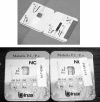Update on rapid diagnostic testing for malaria
- PMID: 18202438
- PMCID: PMC2223842
- DOI: 10.1128/CMR.00035-07
Update on rapid diagnostic testing for malaria
Abstract
To help mitigate the expanding global impact of malaria, with its associated increasing drug resistance, implementation of prompt and accurate diagnosis is needed. Malaria is diagnosed predominantly by using clinical criteria, with microscopy as the current gold standard for detecting parasitemia, even though it is clearly inadequate in many health care settings. Rapid diagnostic tests (RDTs) have been recognized as an ideal method for diagnosing infectious diseases, including malaria, in recent years. There have been a number of RDTs developed and evaluated widely for malaria diagnosis, but a number of issues related to these products have arisen. This review highlights RDTs, including challenges in assessing their performance, internationally available RDTs, their effectiveness in various health care settings, and the selection of RDTs for different health care systems.
Figures


References
-
- Anthony, R. L., M. J. Bangs, J. M. Anthony, and Purnomo. 1992. On-site diagnosis of Plasmodium falciparum, P. vivax, and P. malariae by using the quantitative buffy coat system. J. Parasitol. 78:994-998. - PubMed
-
- Baker, J., J. McCarthy, M. Gatton, D. E. Kyle, V. Belizario, J. Luchavez, D. Bell, and Q. Cheng. 2005. Genetic diversity of Plasmodium falciparum histidine-rich protein 2 (PfHRP2) and its effect on the performance of PfHRP2-based rapid diagnostic tests. J. Infect. Dis. 192:870-877. - PubMed
-
- Banoo, S., D. Bell, P. Bossuyt, A. Herring, D. Mabey, F. Poole, P. G. Smith, N. Sriram, C. Wongsrichanalai, R. Linke, R. O'Brien, M. Perkins, J. Cunningham, P. Matsoso, C. M. Nathanson, P. Olliaro, R. W. Peeling, and A. Ramsay. 2006. Evaluation of diagnostic tests for infectious diseases: general principles. Nat. Rev. Microbiol. 4:S20-S32. - PubMed
-
- Barat, L., J. Chipipa, M. Kolczak, and T. Sukwa. 1999. Does the availability of blood slide microscopy for malaria at health centers improve the management of persons with fever in Zambia? Am. J. Trop. Med. Hyg. 60:1024-1030. - PubMed
-
- Behrens, R. H., and C. J. Whitty. 2000. Self-use of rapid tests for malaria diagnosis. Lancet 355:237. - PubMed
Publication types
MeSH terms
Substances
LinkOut - more resources
Full Text Sources
Other Literature Sources
Medical

